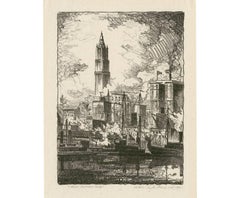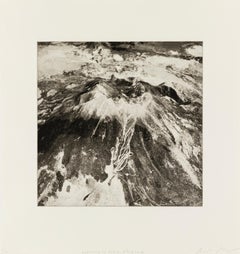South Carolina - Landscape Prints
to
5
60
3
Overall Width
to
Overall Height
to
29
7
3
2
6
6
4
3
3
1
59
3
3
20
14
11
4
1
3
40
19
3
32
17
14
12
12
11
9
6
6
6
5
5
4
4
4
4
3
3
3
3
28
16
10
9
9
11,413
4,627
Item Ships From: South Carolina
'Bridges of Florence' — Firenze Impressionism
Located in Myrtle Beach, SC
Alonzo C. Webb, 'Bridges of Florence', etching, 1929, edition 100. Signed and titled in pencil. Signed and dated in the plate, lower left. A superb, richly-inked impression, in warm ...
Category
1920s American Impressionist South Carolina - Landscape Prints
Materials
Etching
New York Skyline, Sketch
By John Taylor Arms
Located in Myrtle Beach, SC
A fine impression, on cream wove paper, with full margins (5/8 to 1 3/8 inches), in excellent condition. Edition 20. Signed and dated in pencil. Annotated 'Bolton Brown...
Category
1920s American Realist South Carolina - Landscape Prints
Materials
Lithograph
'Humphrey's Peak, Arizona' — from the series 'Axis Mundi', Contemporary
Located in Myrtle Beach, SC
Beth Ganz, 'Humphrey's Peak, Arizona', copperplate photogravure etching, edition 10, 2021. Signed, titled, and numbered 6/10 in pencil. A superb, richly-inked impression in warm black ink, on cream, wove, cotton rag paper; the full sheet in excellent condition. Archivally sleeved, unmatted.
Image size 10 1/2 x 10 1/2 inches; sheet size 16 x 15 1/2 inches.
From the artist's series of 64 photogravure etchings, 'Axis Mundi'. Additional works from the series are available; please inquire.
Exhibited: 'Photography in Ink, A Look at Contemporary Copper-Plate Photogravure,' Curated by Leandro Villaro, Penumbra Exhibition Space Gallery, Nov 30, 2022 - March 15, 2023.
ABOUT THE IMAGE
Humphreys Peak (Hopi: Aaloosaktukwi, Navajo: Dookʼoʼoosłííd) is the highest natural point and the second most prominent peak after Mount Graham in the U.S. state of Arizona, with an elevation of 12,637 feet (3,852 m) and is located within the Kachina Peaks Wilderness in the Coconino National Forest, about 11 miles (17.7 km) north of Flagstaff, Arizona. Humphreys Peak is the highest of a group of dormant volcanic peaks known as the San Francisco Peaks.
Humphreys Peak was named in about 1870 for General Andrew A. Humphreys, a U.S. Army officer who was a Union general during the American Civil War and who later became Chief of Engineers of the United States Army Corps of Engineers.
The San Francisco Peaks are a sacred place for Hopi, Navajo, Havasupai, Zuni, Apache, and other Native American tribes. A place of sacred shrines and ancestral dwellings, The Peaks are associated with emergence, deities, ancestors, life-giving moisture, and spiritual ceremony and are still actively utilized today. Numerous medicinal herbs and other plants used in traditional ceremonies and to treat ailments are found at several levels of the Peaks. The plants are said to have place-specific energies—that is, they must come from these sacred sites to fulfill their proper function.
To the Hopi, the Peaks are Nuvatukaovi, “The Place of Snow on the Very Top,” home for half the year to the ancestral kachina spirits who live among the clouds around the summit. When properly honored through song and ceremony, it is believed that the kachinas will bring gentle rains to thirsty crops.
ABOUT THE SERIES 'AXIS MUNDI'
"This body of work focuses on satellite images of sacred mountains around the world—places where heaven and earth are thought to meet. The phenomenon of revering mountains as holy sites is an archetype found in many cultures.
"This shared experience finds a visual echo in the ubiquity of images of the earth that are now available to any person with a computer and an Internet connection. What does the specificity of place mean when we can move across the surface of the earth in seconds and reduce everything to a series of pixels? To me, this process recalls abstract painting, which transforms the specific into gesture and form. Rather than treat digital technology as necessarily destructive to human meaning and experience, my work offers new ways of seeing that are reconcilable with the old. To this end, I combine 19th Century Photogravure technique with 21st Century surveillance captures.
"Axis Mundi consists of 64 copperplate photogravures. The work is laid out in a grid, which is an arbitrary conversion of the visual world into a flat space that happens both on the picture plane and in the data processing. The title refers to the belief in a 'world center,' often conceived of as a mountain: a place where communication between higher and lower realms is possible. This project is a search for such a center in a world of decentralization and fragmentation."
—Beth Ganz
ABOUT THE ARTIST
Beth Ganz is a contemporary American multidisciplinary visual artist, who lives and works in New York City. She graduated from Pratt Institute with a BFA (honors) in Painting, Sculpture, and Printmaking. The focus of her work is the intersection of landscape, digital technology, and abstraction. Ganz works in paint, brush, and ink drawing, both independently and alongside digital and analog printing techniques, including photogravure and intaglio printing.
Ganz’s work has been the subject of many solo exhibitions, including 'Atlas Project' at Cynthia-Reeves Gallery, 'Up Close and Far Away, Grids and Toiles: Beth Ganz at Wave Hill House,' Wave Hill, and 'Geothermal Topographies' at Reeves Contemporary. She has been shown in numerous group exhibitions, and her work is represented in many public and private collections, including the 9-11 Memorial Museum, the Library of Congress, the New York Historical Society, and the New York Public Library Prints Collection.
Ganz teaches workshops in photogravure and intaglio at Manhattan Graphics Center and has been a long-time grantee of the Elizabeth Foundation for the Arts.
AWARDS AND RESIDENCIES
2018 – Signal: Tri-State Juried Exhibition (2nd Place), Katonah Museum of Art, Katonah, New York (Juror: Lumi Tan)
2001-2014 – Studio Program, Elizabeth Foundation for the Arts, New York, NY
2005 – Johnson & Johnson Purchase Prize, 48th Annual National Print Exhibition, Hunterdon Museum of Art, Clinton, NJ
1999 – Prints USA Juror’s Award, Springfield Art Museum, Springfield, MO
1993 – 37th Annual National Print Exhibition (Honorable Mention), Hunterdon Art Center, Clinton, NJ
1992 – Small Impressions 1992 (Juror’s Award), Printmaking Council of New Jersey, NJ
BIBLIOGRAPHY: MAGAZINES, JOURNALS, NEWSPAPERS, AND ONLINE MEDIA
2018 – Mary Legrand, “A Signal of Invention,” Bedford Record, July 2018
2017 – Sara Mintz, “Profile of an Artist: Beth Ganz,” Journal of the Print World, Vol. 40, #4, October 2017
2017 – Cate McQuaid, “Critics’ Picks, The Ticket: Music, Theater, Dance, Art and more,” Boston Globe, May 2017 4, 2017
2017 – Beth Ganz, “New Prints: Beth Ganz and the Atlas Project Landscape,” Journal of the Print World, I Vol. 40, #3, July 2017
Collections: Duke Energy, Charlotte, NC; Evelyn Lauder Breast Center at SKMCC, New York, NY; Frost Bank, Houston, Texas; Hofstra Museum, Hofstra University; Johnson and Johnson...
Category
21st Century and Contemporary Contemporary South Carolina - Landscape Prints
Materials
Etching, Photogravure
Recently Viewed
View AllMore Ways To Browse
Walter Westbrook
Warhol Neuschwanstein
Wendy Chazin
Wesley Simpson
Wilhelm Velten
William Callcott Knell
William Didier Pouget
William Gaw
William S Horton
William Secord Gallery
William Skilling Monkey
William Stewart Macgeorge
Willy Eisenschitz
Yorkshire House Inc
Zhang Zhengdao
Zoe Mozert
A H Vickers Oil Painting
Aaron Bushnell


